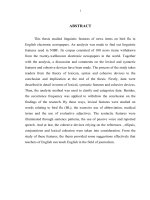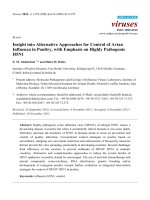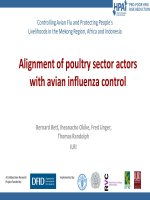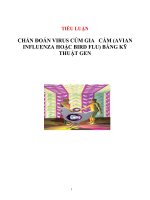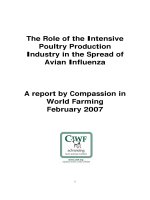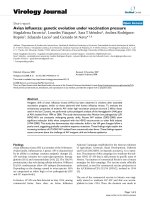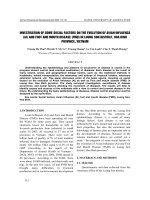avian influenza - bird flu
Bạn đang xem bản rút gọn của tài liệu. Xem và tải ngay bản đầy đủ của tài liệu tại đây (706.59 KB, 21 trang )
World Health Organization
Avian Influenza
Bird flu
World Health Organization
Outline
•
What is influenza?
•
What is Avian Influenza?
•
What is the current situation?
•
Why is WHO concerned?
•
What needs to be done?
World Health Organization
Influenza (Flu)
•
Viral disease
•
Three types: A, B and C
•
Affect humans and other animals
such as birds and pigs
•
Seasonal epidemics in temperate
climates
•
Occasional pandemics (global
epidemic)
World Health Organization
Influenza pandemics in the 20
th
Century
1918: “Spanish Flu” 1957: “Asian Flu” 1968: “Hong Kong Flu”
40-50 million
deaths
1 million
deaths
1 million
deaths
•
New virus strain
•
No immunity
•
Able to spread easily from person to person
World Health Organization
Structure of influenza A
H (hemagglutinin)
N (neuraminidase)
World Health Organization
(Karl G Nicholson, et al Lancet 2003; 362: 1733-45)
•
Many subtypes
•
15 H and 9 N can mix
in different combinations
H1
H2
H3
H4
H5
H6
H7
H8
H9
H10
H12
H13
H14
H15
H11
N1
N2
N3
N4
N5
N6
N7
N8
N9
Influenza A viruses are classified by H and N types
World Health Organization
What is Avian Influenza?
Bird Flu
•
Disease of wild birds, mainly waterfowl (e.g wild ducks)
•
Does not usually cause severe illness in wild birds
•
Domestic birds are more susceptible to some strains
•
Virus excreted in faeces and respiratory secretions
•
Human infections with avian influenza can occur, but rarely
•
Influenza pandemics are thought to be caused by viruses that
are avian/human influenza hybrids
World Health Organization
Recent human infections by Avian Influenza
Year Place Subtype Cases Deaths
1997 Hong Kong H5N1 18 6
1999 Hong Kong H9N2 2 0
2003 Hong Kong H5N1 2 1
2003 Netherlands H7N7 89 1
World Health Organization
How might a pandemic strain appear?
(First Mechanism)
Migratory water
birds
Domestic birds
World Health Organization
How might a pandemic strain appear?
(Second Mechanism)
Migratory water
birds
Domestic birds
World Health Organization
How might a pandemic strain appear?
(Third Mechanism)
Migratory water
birds
Domestic birds
World Health Organization
Current avian influenza situation
COUNTRY TYPE
Korea H5N1
Vietnam H5 (N1)
Japan H5
Taiwan, Province of China H5N2
Thailand H5 (N1)
Cambodia H5
Hong Kong, SAR H5N1
China H5N1
Lao, PDR H5
Pakistan H7(H9)
Indonesia H5N1
World Health Organization
Provinces with confirmed
H5N1 Poultry Infection
(N=42)
Confirmed Human Cases
(N=10)
Situation in Viet Nam: Feb 1, 2004
World Health Organization
Why is WHO concerned?
•
Risk to humans from H5N1
•
Risk of pandemic virus
developing
World Health Organization
What do we have to do?
•
Stop transmission of avian virus to humans
–
Contain the outbreak in animals
–
Protect humans
•
Prepare for a virus with pandemic potential
–
Detect and investigate human cases
–
Characterise the virus
–
Prepare a vaccine prototype
World Health Organization
How will it be done?
•
Contain the animal outbreak
–
Surveillance
–
Slaughter
–
Quarantine
–
Restrict movements
•
Protect humans
–
Education and advice
–
Protection for people killing sick chickens
–
Infection control in health care settings
–
Early diagnosis and treatment
•
Detect and investigate human cases
–
Enhanced surveillance
–
Investigate the source of infection
•
Characterise the virus
World Health Organization
Vaccination
•
Current vaccine
–
Does not protect against H5N1
–
Would reduce the chance of human /
avian co-infection and reassortment
•
H5N1 vaccine
–
6-8 months for vaccine production
–
Limited supply
•
Egg supply
•
250 million doses in 2001
•
Global shortage
World Health Organization
Antiviral drugs
•
Amantadine
–
Resistance
•
Oseltamivir (Tamiflu)
–
Expensive ($2 per capsule)
–
Limited availability
–
Must be used early (first 48 hours)
–
Can protect against infection
World Health Organization
General advice
•
Avoid high risk areas – farms, live poultry markets
•
If you do have contact with a high risk environment
- wash your hands well
•
If you develop a fever (>37.5)
–
consult your doctor
–
stay at home
•
If you visit a patient - follow advice of hospital staff
•
WHO does not recommend any travel restrictions
World Health Organization
Food safety
•
No cases of avian influenza linked to eating poultry or eggs
•
Faecal contamination of the surface of the eggs could occur:
take care and wash eggs
•
Eggs from infected birds may contain the virus but the virus
is inactivated by cooking
•
Observe good hygiene practices handling raw poultry meat
•
Influenza viruses are destroyed by heat
•
Influenza viruses are destroyed by household disinfectants
World Health Organization
Thank you
